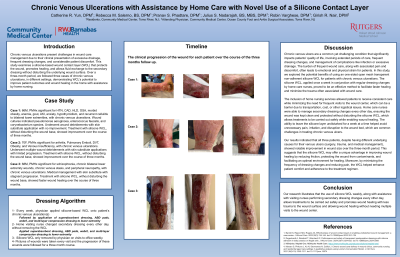Case Series/Study
(CS-175) Chronic Venous Ulcerations with Assistance by Home Care with Novel Use of a Silicone Contact Layer
Friday, May 2, 2025
7:45 PM - 8:45 PM East Coast USA Time

Rebecca Salerno, BS, DPM – PGY-2; Pranav Phadtare, DPM – PGY-3; Julius Nadarajah, BS, MBS, DPM – PGY-3; Robin Varghese, DPM – PGY-2; Girish Nair, DPM – Attending
Introduction: Chronic venous ulcerations present challenges in wound care management due to their clinical presentation of excessive drainage, frequent dressing changes, and considerable patient discomfort. This study examines a silicone-based wound contact layer (WCL) that protects the wound, promotes healing, and allows fluid exchange to the secondary dressing without disturbing the underlying wound surface. Over a three-month period, we followed three cases of chronic venous ulcerations, in different settings, demonstrating WCL’s potential to improve patient outcomes and wound healing in the home with assistance by home nursing.
Methods: Patients with non-improving chronic venous ulcerations, that were seen every one to two weeks at the wound center and additionally had assistance by home care nurses, were selected for the study with complex wounds that require multiple dressing changes per week. We selected three patients for this study. We saw them every one to two weeks for assessments and management. Everytime we applied dressings to their wounds we ensured it included the silicone WCL. In the interim, visiting nurses were changing the secondary dressing every other day, and not removing the WCL. Silicone layer was only removed once a week. Pictures of the wounds were taken every visit, and we followed the progression of these wounds for three months.
Results: All three patients from different initial causes (surgery, trauma, and medical management) clinically improved, as their wound sizes decreased over the course of three months duration.
Discussion: Chronic venous ulcerations can be a long and tough battle for patients. Varied skills and consistency with assistance by home care may at times impede wound healing. However, our research of using an one-sided open mesh transparent non-adherent silicone WCL weekly allows visiting nurses the ability to observe and change the secondary dressing every other day without removing the WCL. This minimizes disturbance, pain, and trauma to the actual wound bed, which has facilitated faster healing for our three patients over the course of three months. It is difficult for patients to come into the wound center frequently due to factors such as economical reasons, and the use of the silicone WCL along with home care allow treatments to be carried out safely while enabling wound healing.
Methods: Patients with non-improving chronic venous ulcerations, that were seen every one to two weeks at the wound center and additionally had assistance by home care nurses, were selected for the study with complex wounds that require multiple dressing changes per week. We selected three patients for this study. We saw them every one to two weeks for assessments and management. Everytime we applied dressings to their wounds we ensured it included the silicone WCL. In the interim, visiting nurses were changing the secondary dressing every other day, and not removing the WCL. Silicone layer was only removed once a week. Pictures of the wounds were taken every visit, and we followed the progression of these wounds for three months.
Results: All three patients from different initial causes (surgery, trauma, and medical management) clinically improved, as their wound sizes decreased over the course of three months duration.
Discussion: Chronic venous ulcerations can be a long and tough battle for patients. Varied skills and consistency with assistance by home care may at times impede wound healing. However, our research of using an one-sided open mesh transparent non-adherent silicone WCL weekly allows visiting nurses the ability to observe and change the secondary dressing every other day without removing the WCL. This minimizes disturbance, pain, and trauma to the actual wound bed, which has facilitated faster healing for our three patients over the course of three months. It is difficult for patients to come into the wound center frequently due to factors such as economical reasons, and the use of the silicone WCL along with home care allow treatments to be carried out safely while enabling wound healing.

.jpg)